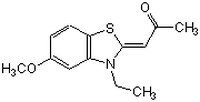219479 Sigma-AldrichCdc2-Like Kinase Inhibitor, TG003 - CAS 300801-52-9 - Calbiochem
The Cdc2-Like Kinase Inhibitor, TG003, also referenced under CAS 300801-52-9, controls the biological activity of Cdc2-Like. This small molecule/inhibitor is primarily used for Phosphorylation & Dephosphorylation applications.
More>> The Cdc2-Like Kinase Inhibitor, TG003, also referenced under CAS 300801-52-9, controls the biological activity of Cdc2-Like. This small molecule/inhibitor is primarily used for Phosphorylation & Dephosphorylation applications. Less<<Synonyms: (Z)-1-(3-Ethyl-5-methoxy-2,3-dihydrobenzothiazol-2-ylidene)propan-2-one, Clk Inhibitor, TG003
Recommended Products
Přehled
| Replacement Information |
|---|
Tabulka spec. kláve
| CAS # | Empirical Formula |
|---|---|
| 300801-52-9 | C₁₃H₁₅NO₂S |
| References | |
|---|---|
| References | Muraki, M., et al. 2004. J. Biol. Chem. 279, 24246. |
| Product Information | |
|---|---|
| CAS number | 300801-52-9 |
| ATP Competitive | Y |
| Form | Off-white solid |
| Hill Formula | C₁₃H₁₅NO₂S |
| Chemical formula | C₁₃H₁₅NO₂S |
| Reversible | Y |
| Structure formula Image | |
| Applications |
|---|
| Physicochemical Information | |
|---|---|
| Cell permeable | Y |
| Dimensions |
|---|
| Materials Information |
|---|
| Toxicological Information |
|---|
| Safety Information according to GHS |
|---|
| Safety Information |
|---|
| Product Usage Statements |
|---|
| Packaging Information | |
|---|---|
| Packaged under inert gas | Packaged under inert gas |
| Transport Information |
|---|
| Supplemental Information |
|---|
| Specifications |
|---|
| Global Trade Item Number | |
|---|---|
| Katalogové číslo | GTIN |
| 219479 | 0 |
Documentation
Cdc2-Like Kinase Inhibitor, TG003 - CAS 300801-52-9 - Calbiochem MSDS
| Title |
|---|
Cdc2-Like Kinase Inhibitor, TG003 - CAS 300801-52-9 - Calbiochem Certificates of Analysis
| Title | Lot Number |
|---|---|
| 219479 |
References
| Přehled odkazů |
|---|
| Muraki, M., et al. 2004. J. Biol. Chem. 279, 24246. |












